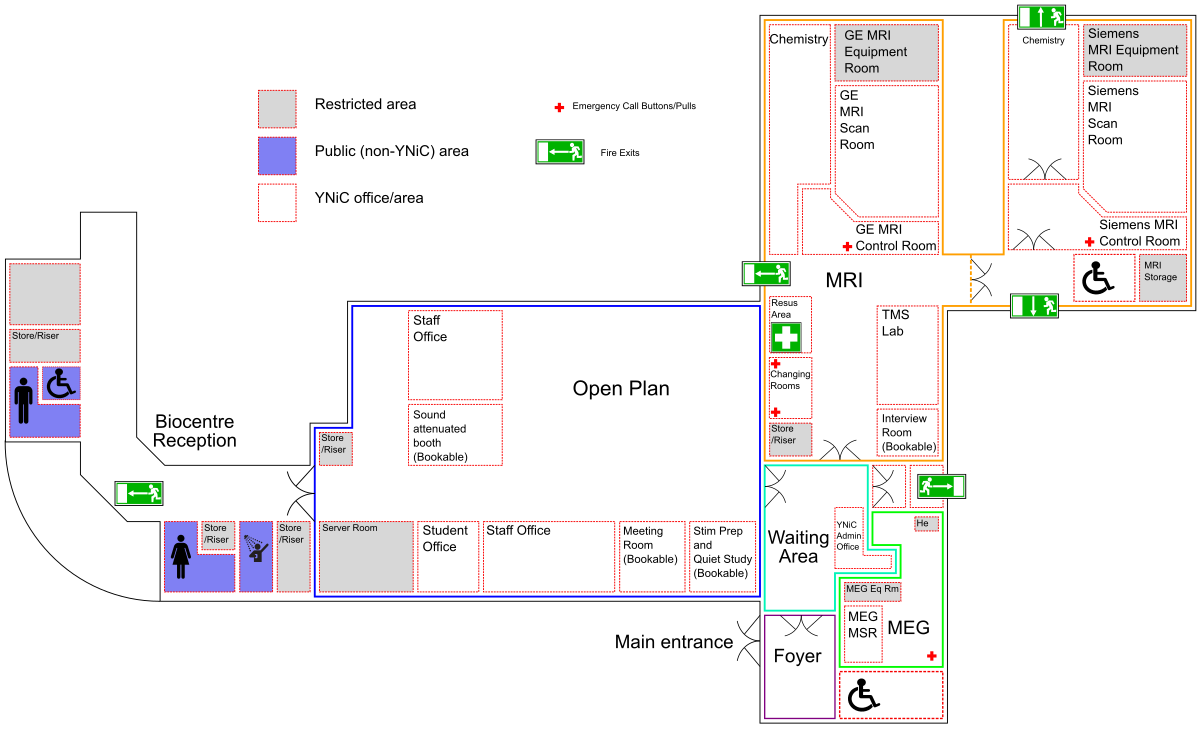Important safety Information For Users
York NeuroImaging Centre, University of York
Table of Contents
Table of Contents
YNiC contains a number of very hazardous substances and pieces of equipment. It is the responsibility of all those within the department to observe the safety guidelines displayed within the department and the advice given by trained personnel. The failure of anyone to observe the documented safe practices may jeopardize the health and safety of others within the department and may result in the termination of a project.
Please note that the 3 Tesla magnets are Always On and therefore No Metal is to be taken into the MRI rooms at any time. Any metal in a magnet room is a potentially deadly projectile, and a severe danger to you and anyone else in the room.
The Full Consent forms contain a General YNiC Consent form and accompanying YNiC Safety Questionnaire. These must be completed by every participant prior to the start of any study. The Safety Questionnaire and Scan Consent Form must be re-completed in collaboration with an Approved Operator prior to each separate procedure by every participant.
Under no circumstances may anyone enter the MRI magnet rooms in the abscence of an MRI operator.
High radiofrequency fields of up to 80kw at 128Mhz are used which will induce currents in any metal exposed to these fields and may lead to heating sufficient to cause skin burns.
Both liquid helium and liquid nitrogen are regularly used at YNiC. These are both extremely cold (as low as -269oC) and therefore have the potential to cause freeze burns if handled incorrectly. The handling of the cryogen bottles and dewars must therefore only be carried out by a trained operator.
Cryogen boil off. If you enter any MRI or MEG area and observe a white cloud of gas, this could be due to freezing gases being present and Oxygen levels may be dangerously low. Oxygen level alarms are present and may be sounding. If you suspect a low oxygen level, leave the area immediately and alert a member of YNiC staff who will deal with the situation.
Users of YNiC who are non-keyholders will never be subject to lone working conditions within the centre, as a key-holder must be present at all times.
Both MEG and MRI have a number of different localised alarms e.g. low/high oxygen flow etc. which sound within the respective areas only. These will be highlighted to all new users during equipment training sessions. In the event of users hearing these alarms, they should notify a member of YNiC staff immediately.
In case of a fire emergency, proceed to the nearest fire exit and operate the nearest break glass fire alarm point which are located adjacent to each fire exit. The alarm will sound and the fire brigade will be automatically summoned. Proceed immediately to the nearest exit and gather at the location marked in the Biocentre car park where a register will be taken. All fire exits in YNiC are alarmed and must never be used except in a case of emergency.
In the case of a Medical Emergency, press the nearest Nurse Call alarm button. These are located on the wall in the MEG and GE and Siemens MRI control rooms, the participant preparation area, the participant changing areas and in the disabled toilet. Know the location of these buttons, which emit a continuous alarm to summon qualified personnel. Ring 3-333 (the internal security emergency number). Remind security that they must inform the emergency services that an MRI magnet is on site.
The location of Nurse Call buttons are marked by a red cross character in the following map:
